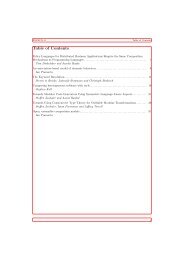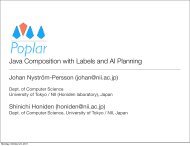Identification of Crosscutting in Software Design - ResearchGate
Identification of Crosscutting in Software Design - ResearchGate
Identification of Crosscutting in Software Design - ResearchGate
You also want an ePaper? Increase the reach of your titles
YUMPU automatically turns print PDFs into web optimized ePapers that Google loves.
2.1 Matrix representation<br />
In this section, we describe how crosscutt<strong>in</strong>g can be identified and<br />
represented <strong>in</strong> matrices. As start<strong>in</strong>g po<strong>in</strong>t, the developer must<br />
establish a dependency matrix show<strong>in</strong>g the mapp<strong>in</strong>g between<br />
source and target. From this matrix, we derive the crosscutt<strong>in</strong>g<br />
matrix, where we represent the crosscutt<strong>in</strong>g source elements.<br />
Then, we describe how the crosscutt<strong>in</strong>g matrix can be constructed<br />
from the dependency matrix with some auxiliary matrices. This is<br />
illustrated with some examples.<br />
2.2 Def<strong>in</strong>itions <strong>of</strong> matrices<br />
The relation between source elements and target elements can be<br />
represented <strong>in</strong> a matrix that we called dependency matrix. As<br />
described before, the mapp<strong>in</strong>g can have different types, such as<br />
usage and abstraction dependencies (e.g. realization, ref<strong>in</strong>ement<br />
and trac<strong>in</strong>g [24]). A dependency matrix (source x target)<br />
represents the dependency relation between source elements and<br />
target elements (<strong>in</strong>ter-level relationship). In the rows, we have the<br />
source elements, and <strong>in</strong> the columns, we have the target elements.<br />
In this matrix, a cell with 1 denotes that the source element (<strong>in</strong> the<br />
row) is mapped to the target element (<strong>in</strong> the column).<br />
Reciprocally this means that the target element addresses the<br />
source element. Scatter<strong>in</strong>g and tangl<strong>in</strong>g can easily be visualized <strong>in</strong><br />
this matrix (see the examples below).<br />
We def<strong>in</strong>e an auxiliary concept crosscutpo<strong>in</strong>t used <strong>in</strong> the context<br />
<strong>of</strong> dependency matrices, to denote a matrix cell <strong>in</strong>volved <strong>in</strong> both<br />
tangl<strong>in</strong>g and scatter<strong>in</strong>g. If there is one or more crosscutpo<strong>in</strong>ts<br />
then we say we have crosscutt<strong>in</strong>g.<br />
<strong>Crosscutt<strong>in</strong>g</strong> between source elements for a given mapp<strong>in</strong>g to<br />
target elements, as shown <strong>in</strong> a dependency matrix, can be<br />
represented <strong>in</strong> a crosscutt<strong>in</strong>g matrix. A crosscutt<strong>in</strong>g matrix (source<br />
x source) represents the crosscutt<strong>in</strong>g relation between source<br />
elements, for a given source to target mapp<strong>in</strong>g (represented <strong>in</strong> a<br />
dependency matrix). In the crosscutt<strong>in</strong>g matrix, a cell with 1<br />
denotes that the source element <strong>in</strong> the row is crosscutt<strong>in</strong>g the<br />
source element <strong>in</strong> the column. In section 2.3 we expla<strong>in</strong> how this<br />
crosscutt<strong>in</strong>g matrix can be derived from the dependency matrix.<br />
A crosscutt<strong>in</strong>g matrix should not be confused with a coupl<strong>in</strong>g<br />
matrix. A coupl<strong>in</strong>g matrix shows coupl<strong>in</strong>g relations between<br />
elements at the same level (<strong>in</strong>tra-level dependencies). In some<br />
sense, the coupl<strong>in</strong>g matrix is related to the design structure matrix<br />
[4]. On the other hand, a crosscutt<strong>in</strong>g matrix shows crosscutt<strong>in</strong>g<br />
relations between elements at one level with respect to a mapp<strong>in</strong>g<br />
onto elements at some other level (<strong>in</strong>ter-level dependencies).<br />
We now give an example and use the dependency matrix and<br />
crosscutt<strong>in</strong>g matrix to visualize the def<strong>in</strong>itions (S denotes a<br />
scattered source element - a grey row; NS denotes a non-scattered<br />
source element; T denotes a tangled target element - a grey<br />
column; NT denotes a non-tangled target element). The example<br />
is shown <strong>in</strong> Table 1, represent<strong>in</strong>g the mapp<strong>in</strong>g from Figure 1.<br />
Table 1. Example dependency and crosscutt<strong>in</strong>g matrix<br />
dependency matrix<br />
target<br />
t[1] t[2] t[3] t[4]<br />
s[1] 1 0 1 1 S<br />
s[2] 0 1 0 0 NS<br />
s[3] 0 0 1 0 NS<br />
NT NT T NT<br />
source<br />
source<br />
crosscutt<strong>in</strong>g matrix<br />
source<br />
s[1] s[2] s[3]<br />
s[1] 0 0 1<br />
s[2] 0 0 0<br />
s[3] 0 0 0<br />
In this example, we have one scattered source element s[1] and<br />
one tangled target element t[3]. Moreover there is one<br />
crosscutpo<strong>in</strong>t at matrix cell [1,3] (dark grey cell). Apply<strong>in</strong>g our<br />
def<strong>in</strong>ition, we arrive to the crosscutt<strong>in</strong>g matrix. Source element<br />
s[1] is crosscutt<strong>in</strong>g s[3] (because s[1] is scattered over [t[1], t[3],<br />
t[4]] and s[3] is <strong>in</strong> the tangled one <strong>of</strong> these elements, namely t[3]).<br />
The reverse is not true: the crosscutt<strong>in</strong>g relation is not symmetric.<br />
2.3 Construct<strong>in</strong>g crosscutt<strong>in</strong>g matrices<br />
In this section, we describe how to derive the crosscutt<strong>in</strong>g matrix<br />
from the dependency matrix. We use a more extended example<br />
than the previous one. We now show an example with more than<br />
one crosscutpo<strong>in</strong>t, <strong>in</strong> this example 8 po<strong>in</strong>ts (see Table 2; the dark<br />
grey cells).<br />
Table 2. Example dependency matrix with tangl<strong>in</strong>g, scatter<strong>in</strong>g<br />
and several crosscutpo<strong>in</strong>ts<br />
dependency matrix<br />
target<br />
t[1] t[2] t[3] t[4] t[5] t[6]<br />
s[1] 1 0 0 1 0 0 S<br />
s[2] 1 0 1 0 1 1 S<br />
s[3] 1 0 0 0 0 0 NS<br />
s[4] 0 1 1 0 0 0 S<br />
s[5] 0 0 0 1 1 0 S<br />
T NT T T T NT<br />
source<br />
Based on the dependency matrix, we def<strong>in</strong>e some auxiliary<br />
matrices: the scatter<strong>in</strong>g matrix (source x target), and the tangl<strong>in</strong>g<br />
matrix (target x source). These two matrices are def<strong>in</strong>ed as<br />
follows:<br />
- In the scatter<strong>in</strong>g matrix a row conta<strong>in</strong>s only dependency<br />
relations from source to target elements if the source element <strong>in</strong><br />
this row is scattered (mapped onto multiple target elements);<br />
otherwise the row conta<strong>in</strong>s just zero's (no scatter<strong>in</strong>g).<br />
- In the tangl<strong>in</strong>g matrix a row conta<strong>in</strong>s only dependency relations<br />
from target to source elements if the target element <strong>in</strong> this row is<br />
tangled (mapped onto multiple source elements); otherwise the<br />
row conta<strong>in</strong>s just zero's (no tangl<strong>in</strong>g).<br />
For our example <strong>in</strong> Table 2, these matrices are shown <strong>in</strong> Table 3.<br />
We now def<strong>in</strong>e the crosscutt<strong>in</strong>g product matrix, show<strong>in</strong>g the<br />
frequency <strong>of</strong> crosscutt<strong>in</strong>g relations. A crosscutt<strong>in</strong>g product matrix<br />
(source x source) represents the frequency <strong>of</strong> crosscutt<strong>in</strong>g<br />
relations between source elements, for a given source to target<br />
mapp<strong>in</strong>g. The crosscutt<strong>in</strong>g product matrix is not necessarily<br />
symmetric. The crosscutt<strong>in</strong>g product matrix ccpm can be obta<strong>in</strong>ed<br />
through the matrix multiplication <strong>of</strong> the scatter<strong>in</strong>g matrix sm and<br />
the tangl<strong>in</strong>g matrix tm: ccpm = sm . tm where ccpm ik = sm ij tm jk<br />
In this crosscutt<strong>in</strong>g product matrix, the cells denote the frequency<br />
<strong>of</strong> crosscutt<strong>in</strong>g. This can be used for quantification <strong>of</strong> crosscutt<strong>in</strong>g<br />
(crosscutt<strong>in</strong>g metrics). The frequency <strong>of</strong> crosscutt<strong>in</strong>g <strong>in</strong> this<br />
- 2 -




